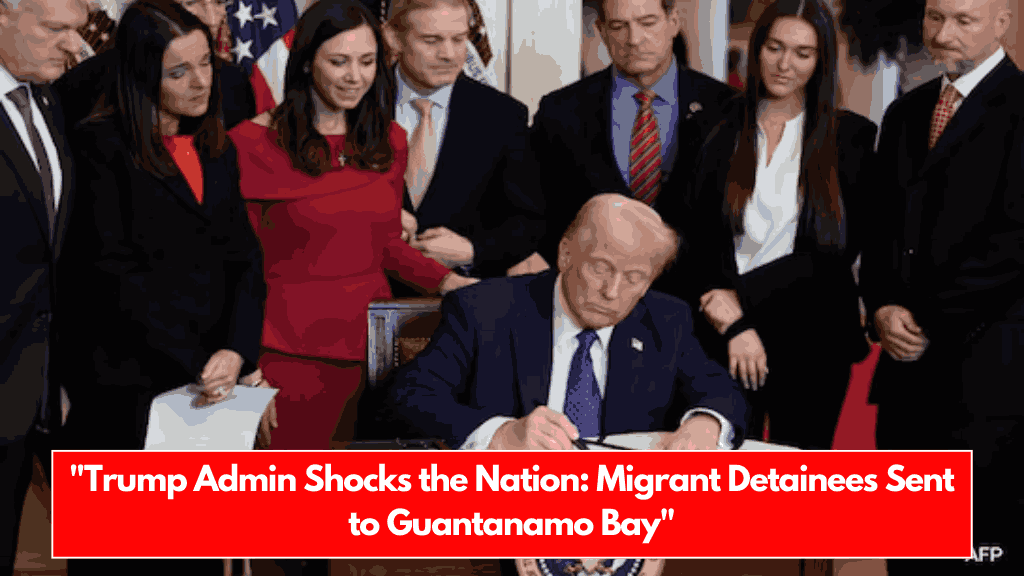The U.S. government has begun converting facilities at the Guantanamo Bay Naval Base into a large-scale immigration detention center following President Trump’s recent directive. On Tuesday, the first group of 10 migrant detainees arrived at the base after being flown from the Fort Bliss Army base in Texas.
Officials confirmed that the detainees are classified as “high-threat” and include Venezuelan men with connections to the Tren de Aragua, a violent gang originating in Venezuela’s prison system. The new detainees will be held in secure cells separate from Guantanamo’s Migrant Operations Center, which has long housed migrants intercepted at sea.
Trump’s Plan for Large-Scale Detention
President Trump ordered the expansion of detention facilities at Guantanamo Bay to accommodate as many as 30,000 unauthorized immigrants with criminal records. This move is part of the administration’s pledge to carry out the largest deportation campaign in U.S. history.
ICE (Immigration and Customs Enforcement) has dramatically increased arrests, averaging 800 to 1,000 daily, compared to the 312 daily average under former President Joe Biden.
Officials are rapidly setting up tent facilities outside the Migrant Operations Center, as the incoming detainees are not expected to be processed or housed there. These temporary facilities are intended to hold individuals before their deportation or further legal processing.
Legal and Operational Challenges
The move to convert Guantanamo Bay into a detention center has raised questions about which agency— the Pentagon or the Department of Homeland Security (DHS)—will have primary custody of the detainees and what legal rights they will have. For decades, Guantanamo has been a controversial site due to its post-9/11 role as a detention center for terrorism suspects.
The Migrant Operations Center currently operates separately from the military prison. Historically, migrants intercepted at sea were housed there temporarily while being screened by U.S. asylum officers.
Migrants who passed initial screenings were often referred for resettlement in countries like Canada or Australia. However, the new detainees will not follow the same process, as many of them face deportation.
Guantanamo’s History with Migrant Detention
This is not the first time Guantanamo Bay has been used to house migrants. In the early 1990s, the Clinton administration detained thousands of Haitian migrants at the base.
Notably, a camp was set up for those diagnosed with HIV, who were banned from entering the U.S. at the time. The current use of Guantanamo, however, is on a much larger scale and focuses on holding migrants with criminal records.
Defense Secretary Hegseth’s Support for the Plan
During a visit to the southwest border on Monday, Defense Secretary Pete Hegseth defended the use of Guantanamo Bay as a detention site, calling it “the perfect place” to house dangerous criminals before their deportation.
“Where are you going to put Tren de Aragua before you send them all the way back?” Hegseth asked. “How about a maximum-security prison at Guantanamo Bay, where we have the space?”
Comparison to Past Detention Practices
While Guantanamo Bay has a long history of housing migrants, the current plan under Trump differs significantly. Previous administrations, including Clinton’s, primarily used the base for temporary detainment and asylum processing. Under Trump, the focus is on long-term detention of migrants classified as high-priority criminals.
The conversion of Guantanamo Bay into a large-scale detention center underscores the Trump administration’s aggressive approach to immigration enforcement.
As ICE continues to arrest large numbers of unauthorized immigrants, legal and operational questions remain about how long migrants will be held at the base and what rights they will have.
With thousands more expected to be detained, Guantanamo Bay’s role in the U.S. immigration system is set to expand significantly in the coming months.
